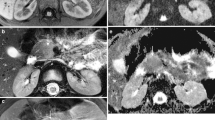Abstract
Objective
This study was designed to determine the effects of intravenous fentanyl on magnetic resonance cholangiopancreatography image quality in the treatment of pancreaticobiliary disorders.
Materials and methods
Forty consecutive patients referred for the evaluation of pancreaticobiliary disorders underwent magnetic resonance cholangiopancreatography in the coronal and oblique–coronal planes before and after fentanyl injection (every 2 up to 9 min). The images were analyzed qualitatively and quantitatively. Diameter and signal intensity were measured at the widest point and distal to the common bile duct and main pancreatic duct.
Results
The mean common bile duct diameters at the widest and distal points and mean pancreatic duct diameter were measured 7.53, 4.72, and 2.14 and 8.33, 5.35, and 2.57 before and after fentanyl injection, respectively. Mean signal intensity at the widest and distal point of the common bile duct and mean pancreatic duct signal intensity measured 278, 199, and 113 and 296, 218, and 121 before and after fentanyl injection, respectively. Minor improvements in image quality were detected qualitatively.
Conclusion
Fentanyl injection improves images qualitatively and quantitatively. In agreement with previous studies, our results confirm the beneficial effects of fentanyl as a simple adjunct to traditional magnetic resonance cholangiopancreatography.


Similar content being viewed by others
References
Cohen SA, Siegel JH, Kasmin FE (1996) Complications of diagnostic and therapeutic ERCP. Abdom Imaging 21:385–394
Duncan HD, Hodgkinson L, Deakin M, et al. (1997) The safety of diagnostic and therapeutic ERCP as a daycare procedure with a selective admission policy. Eur J Gastroentrol Hepatol 9:905–908
Edelman R, Hesselink J, Zlatkin M, et al. (2006) Clinical magnetic resonance imaging; third edition. Philadelphia: Saunders Elsevier, pp 2483–2540
Kaltenthaler EC, Walters SJ, Chilcott J, et al. (2006) MRCP compared to diagnostic ERCP for diagnosis when biliary obstruction is suspected: a systematic review. BMC Imaging 14:6–9
Shanmugam V, Beattie GC, Yule SR, et al. (2005) Is magnetic resonance cholangiopancreatography the new gold standard in biliary imaging? Br J Radiol 78:888–893
Silva AC, Friese JL, Hara AK, et al. (2004) MR cholangiopancreatography: improved ductal distention with intravenous morphine administration. Radiographics 24:677–687
Lee NJ, Kim KW, Kim TK, et al. (2006) Secretin-stimulated MRCP. Abdom Imaging 31:575–581
Agrawal S, Nag P, Sikora S, et al. (2006) Fentanyl-augmented MRCP. Abdom Imaging 31:582–587
Chu ZQ, Ji Q, Zhang Jl (2010) Orally administered lemon/orange juice improved MRCP imaging of pancreatic ducts. Abdom Imaging 35:367–371
Fentanyl citrate dosage form: injection. http://drugs.com/pro/fentanyl-citrate.html
Fig LM, Wahl RL, Stewart RE, et al. (1990) Morphine-augmented hepatobiliary scintigraphy in the severely ill: caution is in order. Radiology 175(2):467–473
Matos C, Metens T, Devière J, et al. (1997) Pancreatic duct: morphologic and functional evaluation with dynamic MR pancreatography after secretin stimulation. Radiology 203:435–441
Manfredi R, Costamagna G, Brizi MG, et al. (2000) Sever chronic pancreatitis versus suspected pancreatic disease: dynamic MR cholangiopancreatography after secretin stimulation. Radiology 214:849–855
Hellund JC, Skattum J, Buanes T, et al. (2007) Secretin-stimulated magnetic resonance cholangiopancreatography of patients with unclear disease in the pancreaticoboliary tract. Acta Radiol 48:135–141
Czako L, Takacs T, Morvay Z, et al. (2004) Diagnostic value of secretin-enhanced magnetic resonance cholangiopancreatography (S-MRCP) after unsuccessful endoscopic retrograde cholangiopancreatography (ERCP). Orv Hetil 145:529–534
Mc Cammon RL, Stoelting RK, Madura JA (1984) Effects of butorphanol, nalbuphine and fentanyl on intrabiliary tract dynamics. Anesth Analg 63:139–142
Acknowledgments
This project was supported by a Grant from the Mazandaran University of Medical Sciences, Sari, Iran.
Conflict of interest
None of the authors has a conflict of interest.
Author information
Authors and Affiliations
Corresponding author
Rights and permissions
About this article
Cite this article
Abdi, R., Fallah-Arzpeima, S. Pancreaticobiliary disorders: comparison between magnetic resonance cholangiopancreatography images before and after fentanyl injection. Abdom Imaging 38, 537–542 (2013). https://doi.org/10.1007/s00261-012-9937-8
Published:
Issue Date:
DOI: https://doi.org/10.1007/s00261-012-9937-8




